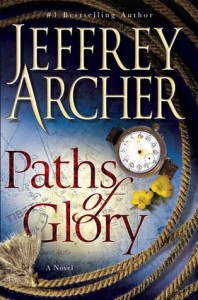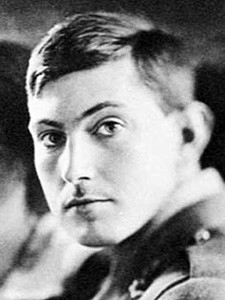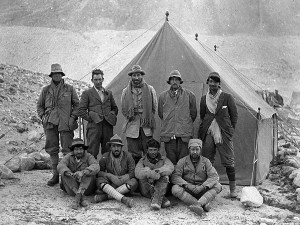In 1924 the mountaineering legend George Mallory vanished into mist on Everest’s Northeast Ridge, never to be seen again. Ever since mountaineers, historians and armchair enthusiasts have argued about whether he and his climbing partner Sandy Irvine reached the summit 29 years before Edmund Hillary and Tenzing Norgay, the pair generally regarded as being Everest’s first summiteers.

In 2009 and the bestselling novelist, politician and raconteur Jeffery Archer, also known as Lord Archer of Weston-super-Mare, wrote a “historical” novel about it called Paths of Glory, which I’ve just finished reading.
Now, I know you may think the title of this blog post is a surprising one. Have I uncovered fresh new evidence that the blockbuster novelist and former deputy-chairman of the Conservative Party, whose political career came to an abrupt end when he was convicted and imprisoned for perverting the course of justice, also physically killed George Mallory high up on the North Face of Everest?
No, of course not – that would be ridiculous. Jeffrey Archer is famous for telling a few porkies about his life, but not even he has claimed to have climbed as high as 8500m on Everest.
I’m talking metaphorically rather than literally. I actually quite enjoyed his book in an expecting-it-to-be-shit-and-not-disappointed kind of a way; it’s certainly an entertaining read. But historical fiction?
Let’s examine Archer’s book in detail. Here are a few events in George Mallory’s life you may not be aware of.
- When he was a ten year old boy Mallory was taken on a school trip to Ben Nevis by his teacher Mr Deacon. Uninspired by the standard route, he sneaked off the back of the group and slipped up Scotland’s highest mountain by a tricky technical route nobody who has been up Ben Nevis since would recognise.
- He turned up late for his interview for a place at Magdalene College, Cambridge, and was denied entry by the porter, so he scaled the wall of the college and jumped down the other side, landing in a flower bed. His tutor Arthur Benson was so impressed by the feat he offered him a place.
- A quick thinking Mallory saved the lives of his two companions while climbing in the Alps as a 19-year-old by arresting their fall with his ice axe. When they tumbled over an overhang, he rescued them by swinging the rope from his ice axe belay like a pendulum until they eventually lurched to safety.
(I can’t think why Simon Yates didn’t try this method with Joe Simpson in Touching the Void, instead of cutting the rope with his knife.)

- While on a school trip to Paris he almost completed a first British ascent of the Eiffel Tower, but was arrested by the gendarmes a few metres from the top.
- During Freshers’ Week at Cambridge University in 1905 he met his future Everest climbing companions Howard Somervell and Noel Odell manning the stand for the Cambridge University Mountaineering Club.
(Both were a few years younger than Mallory, and would have been 15 years old at the time of this incident. Clearly they must have been child prodigies.) - During an ascent of Mont Blanc from Courmayeur in 1906, he stayed for a night in the Grands Mulets hut.
(Courmayeur is on the southern Italian side of the Mont Blanc, but the Grands Mulets hut is on the French side, so this would have been a physical impossibility.) - He survived an avalanche in the Alps in 1906 by swimming breaststroke. After falling in a crevasse and climbing out again, he was was surprised to find his future Everest climbing partner George Finch sitting at the top singing Waltzing Matilda.
- After surviving an avalanche and collapsing from exhaustion on Mont Blanc, he slept through his rescue off the mountain and woke up in a hospital bed.
- The Mount Everest Committee was formed in 1914 after a lecture about Antarctica by Robert Falcon Scott at the Royal Geographical Society.
(It was formed after a lecture about a journey into Tibet by John Noel in 1919.) - Mallory wooed his future wife Ruth by scaling the 100m bell tower of St Mark’s Basilica in Venice while she stood in the Piazza San Marco watching. Unlike the Eiffel Tower incident, he managed to hop on a train and flee the country before the police were able to arrest him.
- At his wedding future Everest climbing partners Guy Bullock, Howard Somervell, Noel Odell and George Finch held their ice axes aloft and formed an archway for the bride and groom to walk through as they left the church.
- The 1921 Everest reconnaissance expedition never happened. That’s right – although history has recorded 12,000 square miles of Tibet were mapped and a route to the summit of Everest identified, it was all just a figment of our imagination and not worth describing.

- The selection process for the 1922 expedition involved an all-day session in a sophisticated torture chamber that would have impressed any James Bond villain. Climbers were expected to ascend a downward escalator (rather like the Travelator in the game show Gladiators) for one hour while fans blew a Himalayan wind across them. The temperature was gradually reduced to -40°C, and the oxygen was sucked out of the room to simulate the atmosphere on the summit of Everest. Finch and Mallory survived the ordeal, but Bullock, Odell, Somervell and Norton all slithered to the bottom of the stairs and landed in an ungainly heap on mats at the bottom.
(I don’t really know where to begin with this one, so I’ll just point out the test would have settled arguments about whether Everest could be climbed without oxygen which raged for more than half a century until Reinhold Messner and Peter Habeler did so in 1978.) - Mallory and Finch supplied their clothing for the 1922 Everest expedition during a shopping trip to the gentlemen’s tailors Ede & Ravenscroft in London, where they purchased Burberry scarfs, umbrellas and a deerstalker hat.
- Guy Bullock and Noel Odell were both members of the 1922 Everest expedition.
(No they weren’t. Bullock was on the 1921 expedition, and Odell the 1924 one.) - Expedition leader General Charles Bruce selected the mules for 1922 expedition by jumping on their backs and trying them out. He also selected the expedition porters personally by jumping on one or two of their backs too.
- Expedition member Edward Norton was so tall his feet touched the ground when he rode a mule.
- Instead of using a tape measure like any normal surveyor, Henry Morshead of the Survey of India employed an Indian exactly six feet tall to measure distances by prostrating on the ground and standing up again.
(He would need to do this nearly 18,000 times a day in order to measure a 20 mile trek.)

- Archer’s description of Mallory’s first sight of Everest is worth quoting word for word. Not only was Mallory able to see both east and west faces of the mountain at the same time, but Archer somehow manages to make the mountain look like a fire-breathing baboon.
“Below her furrowed brow projected a sharp Tibetan nose made up of uneven ridges and unapproachable precipices below which wide nostrils belched out a wind so fierce that even on level ground you would have been prevented from advancing a single stride. But worse, far worse, this goddess was two-faced. On her west face, the cheekbone was made up of a pinnacle of rock that stretched high into the heavens, far higher than George’s imagination had ever dared to soar, while the east face displayed a mile long sheet of ice that never thawed, even on the longest day of the year. Her noble head rested on a slim neck, nestling in shoulders of granite. From her massive torso hung two long supple arms, attached to large flat hands that offered a slight hope until you saw her ten thin, icy fingers, one of the nails of which was where they hoped to set up base camp.”
(I’m stunned. What on earth must Lord Archer have been smoking when he thought this might be a suitable description for a mountain? Whatever it was, I’d like to try some.)
- At the Tibetan border the Dzongpen of Phari was going to kill General Bruce, but Mallory managed to appease him by producing a box of hats.
- Mallory could see Everest’s Kangshung Face as he left Base Camp in the Rongbuk Valley.
(Only if the goddess Chomolungma was holding up a giant mirror in the sky to reflect Everest’s opposite side could he have done so.)

- Two hours after after leaving Base Camp Mallory passed a willow tree teeming with butterflies at 5200m in the high altitude desert of the Rongbuk Valley.
(If only there had been a biologist accompanying the expedition to witness this extraordinary natural phenomenon. Sadly neither this miraculous tree nor its butterflies have been seen by any expedition since.) - Upon returning to the North Col after their summit attempt Bullock picked up a pair of scissors and began trimming Norton’s frostbitten ear.
(Best not to begin amputation while body parts are still frozen.) - In 1922 Mallory’s oxygenless attempt ended at a height of 27,550 feet (8400m), when Odell became exhausted and Mallory decided to descend with him. Finch was climbing with them (and with oxygen), but chose to continue on his own for a further 100m before giving up. His gentlemanly conduct made Mallory a hero, while Finch was considered a bounder for continuing.
(There were two summit attempts in 1922. On the first one Mallory, Norton and Somervell reached 26,985 feet (8225m) without oxygen before they all agreed to turn round. During the second attempt Finch and Geoffrey Bruce reached 27,300 feet (8320m) with oxygen when Bruce’s oxygen apparatus malfunctioned. Although Finch fixed it for him he could see Bruce was exhausted, so they both descended.) - During a lecture tour of the United States in 1923, Mallory was offered $10,000 to fund the next expedition by a wealthy heiress if he would sleep with her. While she went to the bathroom to slip into a flimsy negligée, Mallory escaped from her apartment by jumping out of the window and climbing down the side of the building like Spiderman.
- Mallory didn’t want to go on the 1924 Everest expedition, but he was talked into it by his wife Ruth after she visited Captain Scott’s widow Kathleen, who convinced her it was her marital duty to let her husband fulfil his destiny.

- By the time the 1924 expedition arrived at Base Camp, Guy Bullock had already established Camp 3 at the head of the East Rongbuk Valley.
(Bullock wasn’t even on the 1924 expedition, and the team ended up having a very difficult time establishing Camp 3. During their first sojourn they had to retreat to Base Camp when storms on the East Rongbuk Glacier left two of their support team dead from altitude sickness and frostbite injuries.) - Half an hour before picking up their packs and setting off on their summit assault, the 1924 expedition team relaxed and calmed their nerves by enjoying a cricket match at Base Camp.
- Mallory learned about the arrival of the monsoon when his sister sent him a telegram from Colombo to tell him it had just arrived off the coast of Ceylon. He received the message while he was at his camp on the North Col.
(Blimey, they had more effective communications in 1924 than we have with our modern satellite technology!) - During his summit attempt Norton became snowblind not by the usual method of getting sunburned cornea, but by his eyelids instantly freezing shut when he removed his goggles.
- Mallory and Irvine were last seen standing on top of the Second Step at 12.50 by Odell at Camp 6. They ended up crawling to the summit on their hands and knees. They took summit photos, and Irvine put the camera in his trouser pocket. During the descent Irvine fell off the Second Step but survived after landing in a bed of snow, and was able to continue unharmed.
(Remarkably, this is actually quite plausible.)
I’m not quite sure why I was expecting Jeffrey Archer’s novel about George Mallory’s life to be historically accurate. A few years ago I read a biography about him by the journalist Michael Crick entitled Jeffrey Archer: Stranger Than Fiction. Crick’s basic premise was that Archer managed to wing his way into various positions of responsibility by making up stories about his life. If he was prepared to take a few liberties with the facts of his own life, why on earth should I expect him to stick to the truth in a fictional account of somebody else’s?

As you can see, most of the book is quite ludicrous. Archer’s research has been cursory, and probably involved little more than reading a book or two. He clearly didn’t feel he needed to visit Tibet to check out the geography, take up climbing, or even talk to a mountaineer to see whether the book sounded even vaguely credible.
But perhaps the most surprising thing is not how absurd most of the book is, but how plausible his conclusion is about George Mallory’s final hours, more plausible than many of the far-fetched theories that have been advanced about Mallory over the years.
What happened to Mallory and Irvine is one of the great mysteries of mountaineering. Odell did indeed see them at 12.50 at the top of a step on the Northeast Ridge while he was climbing to Camp 6. Which step it was has been the subject of much debate. If it was the Second Step, or even the Third Step, then I also believe he reached the summit, as I have discussed in a previous post. As for crawling to the summit on his hands and knees, this sounds ridiculous too, but in fact the Chinese climber Wang Fu-chou described doing precisely this during the first acknowledged ascent by the Northeast Ridge in 1960. As for Irvine falling down the Second Step and surviving, I believe this is possible too. The Second Step is actually a series of steps rather than a single one, and the highest part has a ledge beneath it which is sheltered from the fierce winds that strip much of the ridge of snow. This means snow collects there, and if it was deep enough then it would be perfectly possible to survive a fall. In 1999 Mallory’s body was discovered on the North Face some distance below the First Step, so it is likely both of them were beneath the Second Step when they eventually fell to their deaths. He was not carrying a camera, so it’s likely Irvine had it.
But what does this tell us? That many theories about Mallory are so ludicrous they make Jeffrey Archer sound plausible? Or my own theory about Mallory is so silly even Jeffrey Archer agrees with it?
Perhaps both of these things. All I can say for certain is the legend of George Mallory is a subject worthy of a great historical novel, but we’re still waiting for someone to write it. It wouldn’t be too harsh to say the legend has been murdered with this one. Hopefully some day a better writer than Jeffrey Archer will give it a go.






Your comments on THE ABOMINABLE, the latest “Everest” novel by Dan Simmons would be interesting to read
I haven’t read it but I actually quite enjoyed Dan Simmons’ novel The Terror about the Franklin expedition that missing in the Canadian Arctic in the 19th century. If it’s anything like that then there’s an element of horror thrown in that makes no pretence at being historically authentic. A different category of novel, but thanks for the heads-up. I must check it out.
Fabulous critique. Very well written. I shared it with the Historical Novel Society’s FB page so the writers can see how important it is to get their facts straight. I read Paths of Glory, and yes I had to suspend disbelief on many occasions, but it shows you how important it is when someone tells you a story to not take everything at face value.
Thank you for saving me the time to read the book myself! So many books, so little time, it’s great when someone provides a comprehensive critique on historical accuracy. – I love HF and hate when writers’ research is clearly sloppy.
Margaret
Thanks for sharing, Rachel. Glad I could save you the time, Margaret. Life’s too short to be reading this one. 🙂
Indeed – but a shame because I’ve loved some of JA’s other books – my favourite remains his first: Not a Penny More, Not a Penny Less. (And he was also very encouraging to me personally when he was a judge in a comp that my debut novel was entered for – so I do owe him.)
Hi Margaret,
In that case it’s very likely you will enjoy Paths of Glory much more than I did. I’ve always hated Jeffrey Archer’s writing for its inveterate snobbery, and I have to confess to being slightly biased. I disliked him as a politician and public figure, and find it difficult to separate his personality from his writing. I expect his US readers are much more willing to judge him for his writing alone than we do here in the UK. 😉
Regards,
Mark.
Hi Mark, I hate to read historically inaccurate stuff, so I won’t be bothering – that’s why I’m grateful to have read your post as I might well have given it a go otherwise, on the basis of his past writing.
I just finished reading this novel and knew little about George Mallory or climbing. I was just looking to read about an adventure while stuck in the house on a winters day. I enjoyed it very much although i have to admit some things didn’t make sense to me and you have pointed them out. This book is enough to peak a persons interest to find out more for themselves. I like George Mallory very much and in my mind he will always be the first to summit Mount Everest.
I can assure you that the legend of George Mallory, greatest mountaineer of all time, remains impregnably secure from the intrusions of what I would almost term sensationalist yellow journalism, were that not a baseless insult to legitimate yellow journalists everywhere.
Both my son and I read Archer’s account of Mallory and we really enjoyed it.
I enjoyed the book as a touching romance between the couple but also one between Mallory and his climbing. I took it as a book of fiction. After reading I wanted to do some research on climbing and the history of the sport. I found conflicting views on whether Mallory reached the summit. As I was not there, I will not judge. Any person able to make the climb with or without oxygen has my respect! I do enjoy Archer’s books. He is a good story teller!
ITS A NOVEL. NOT A HISTORY BOOK
Looks like you’ve left caps lock on. It’s on the left-hand side of the keyboard, about halfway up.
@lemon
It is a novel – supposedly a historic novel – and, as such, the author has a duty to stick within the historic background as we know it. It is because so much is not known about history that good historic novels can be written. George MacDonald Fraser’s Flashman novels are excellent examples of the genre with the hero’s exploits slotted neatly into gaps in well researched (and attributed) history.
Unfortunately for the former Lord Archer, Mallory’s life up to June 5th 1924 is so well documented that there is no scope for a serious historic novel about him. And sufficient speculative fiction about his last twos days has been written to make any more redundant 🙂
We need not be so serious whether all facts in the novel are accurate or not. Whatever criticisms , while we enjoying JA’s books we can gather considerable knowledge comparing with most of novels.
I have read Jeffery Archer’s book, not bad but you are right about the made up stuff. I work in a University Library and I ran across a book on surnames, “Surnames Are the Fossils of Speech”, by Samuel L. Brown copyright 1967 and on page 207 it reads:
Mallory (Eng) Der. from OFr. maleure, a nickname meaning “bad luck or misfortune”.
I have read a good deal about Mallory and Irvine and I would like to believe they made it to the top, but I don’t think so.
Larry Tomikel
This was an excellent book review – one of the best of thousands I’ve read. Mallory and his kind are more deserving of study than the nonsense of the modern Olympics.
The note that abundance of documentation and speculation on someone’s life indicates that nothing more is needed is absurd. Documentation can be contradictory or so unusual that it needs its own analysis (which itself can’t be conclusive). One example is the surviving materials on the Dieppe Raid: the obvious gaps raise serious unanswered questions while other plain assertions by highly respectable people seem dubious. A second example is the ‘government’ work supposedly done by Somerset Maugham, often cited as clear fact by biographers, but becoming ever less clear with more thoughtful study. Lots to do, and fun with the doing!
If the people who criticise Jeffrey Archer’s book ,Paths of Glory took time to actually read the statement at the beginning of the book they would see the words, Inspired by a true story.Rather than all the academic snobbery and me thinks, jealousy then it can be accepted as a jolly good read. It doesn’t claim to be the real truth .It certainly inspired me to find out more about George Mallory, something I would not have done if I hadn’t read the book.